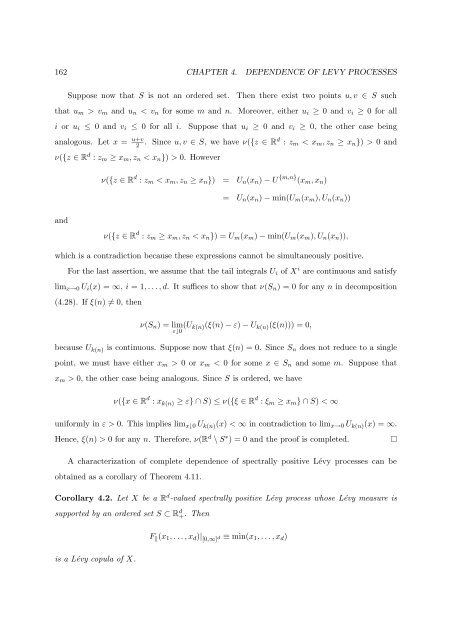Processus de Lévy en Finance - Laboratoire de Probabilités et ...
Processus de Lévy en Finance - Laboratoire de Probabilités et ...
Processus de Lévy en Finance - Laboratoire de Probabilités et ...
You also want an ePaper? Increase the reach of your titles
YUMPU automatically turns print PDFs into web optimized ePapers that Google loves.
162 CHAPTER 4. DEPENDENCE OF LEVY PROCESSES<br />
Suppose now that S is not an or<strong>de</strong>red s<strong>et</strong>.<br />
Th<strong>en</strong> there exist two points u, v ∈ S such<br />
that u m > v m and u n < v n for some m and n. Moreover, either u i ≥ 0 and v i ≥ 0 for all<br />
i or u i ≤ 0 and v i ≤ 0 for all i. Suppose that u i ≥ 0 and v i ≥ 0, the other case being<br />
analogous. L<strong>et</strong> x = u+v<br />
2 . Since u, v ∈ S, we have ν({z ∈ Rd : z m < x m , z n ≥ x n }) > 0 and<br />
ν({z ∈ R d : z m ≥ x m , z n < x n }) > 0. However<br />
ν({z ∈ R d : z m < x m , z n ≥ x n }) = U n (x n ) − U {m,n} (x m , x n )<br />
= U n (x n ) − min(U m (x m ), U n (x n ))<br />
and<br />
ν({z ∈ R d : z m ≥ x m , z n < x n }) = U m (x m ) − min(U m (x m ), U n (x n )),<br />
which is a contradiction because these expressions cannot be simultaneously positive.<br />
For the last assertion, we assume that the tail integrals U i of X i are continuous and satisfy<br />
lim x→0 U i (x) = ∞, i = 1, . . . , d. It suffices to show that ν(S n ) = 0 for any n in <strong>de</strong>composition<br />
(4.28). If ξ(n) ≠ 0, th<strong>en</strong><br />
ν(S n ) = lim<br />
ε↓0<br />
(U k(n) (ξ(n) − ε) − U k(n) (ξ(n))) = 0,<br />
because U k(n) is continuous. Suppose now that ξ(n) = 0. Since S n does not reduce to a single<br />
point, we must have either x m > 0 or x m < 0 for some x ∈ S n and some m. Suppose that<br />
x m > 0, the other case being analogous. Since S is or<strong>de</strong>red, we have<br />
ν({x ∈ R d : x k(n) ≥ ε} ∩ S) ≤ ν({ξ ∈ R d : ξ m ≥ x m } ∩ S) < ∞<br />
uniformly in ε > 0. This implies lim x↓0 U k(n) (x) < ∞ in contradiction to lim x→0 U k(n) (x) = ∞.<br />
H<strong>en</strong>ce, ξ(n) > 0 for any n. Therefore, ν(R d \ S ∗ ) = 0 and the proof is compl<strong>et</strong>ed.<br />
A characterization of compl<strong>et</strong>e <strong>de</strong>p<strong>en</strong><strong>de</strong>nce of spectrally positive Lévy processes can be<br />
obtained as a corollary of Theorem 4.11.<br />
Corollary 4.2. L<strong>et</strong> X be a R d -valued spectrally positive Lévy process whose Lévy measure is<br />
supported by an or<strong>de</strong>red s<strong>et</strong> S ⊂ R d +. Th<strong>en</strong><br />
F ‖ (x 1 , . . . , x d )| [0,∞] d ≡ min(x 1 , . . . , x d )<br />
is a Lévy copula of X.
















